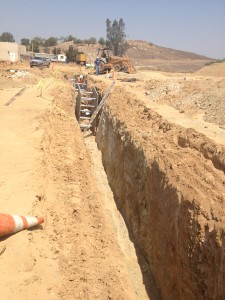Our Commitment to Trench Safety
Underground is the land of the UNKNOWN!
Even when all the measures have been taken to maximize project success and keep all involved safe, the element of surprise still awaits.
Our organization’s history has demonstrated that the safer we execute at the outset, the more successful the project outcome for customers. Trench safety is a very integral part of this diligence.
Alward has developed a culture that promotes an injury free workplace.
Safe practices permeate everything we do and are ingrained into the nature of the company we are.
BEFORE DIGGING
Hitting electrical, water, sewer, cable, or telephone lines can be quite costly and can injure, harm or kill workers. The risks involved with heavy equipment are already high taking the proper precautions. Please do your due diligence on trench safety before we come out to dig for you.
Trench safety points to consider before bucket touches the ground:
- Please do not attempt to have us come out to dig for you unless you have first called DIG ALERT and located all your lines. We must have evidence of a dig ticket no.
- Dig Alert can be reached online at: www.digalert.com
- or by phone: 8-1-1
- When you call DIG ALERT, each of the utility companies will send a representative to mark where their lines are located. The utility companies have 48 hours to mark their lines before digging should commence. So give It’s not only a good idea, in most instances, it’s the law.
- Scan, survey and mark all known existing utilities.
- Notify operator of what utilities are known to be underground, speculations of utilities that are not confirmed BEFORE (s)he begins digging. We love surprises but not this kind!
- Four eyes in every hole = Intelligent Project Execution. Please provide effective, efficient, and knowledgeable labor to work along with the backhoe. This competent person should be familiar with hand signals.
- A great backhoe operator is able to feel vibrations through the controls, however (s)he is only able to see in the trench from one direction. It is critical that (s)he receive support looking in from the other end while digging.
4 EYES ON EVERY TRENCH
Four eyes are better than two when it comes to anything – especially uncovering the land of the UNKNOWN!
The equation is a simple one. There is no rocket science.
Skilled operator on a piece of equipment
+
Distinguished laborer on a shovel
=
Project Success
Which translates into EFFORTLESS EFFORT – Saving YOU Time & Money
A water skier / wake boarder has a spotter in the boat at all times that sees and views from a different angle to where the driver of the boat cannot.
So too should a company when digging a trench. An operator on a piece of heavy equipment is only able to see in the one direction, from quite a distance to where the bucket enters the ground and has the monumental tasks of looking over and around a large piece of iron called the ‘boom’. An exceptional operator – we like give credence where it’s due and call our people “ARTISANS”) can feel vibration of pipe but it’s in your best interest to have a valuable, proficient, and mindful set of eyes ‘spotting’ the trench AT ALL TIMES whom also has the experience to pothole effectively with manual means (ie. shovel) where the mechanical means (backhoe) is not allowed to enter.
If you do not have a competent and experienced laborer who has a trained set of eyes and knows what the warning signs are underground, ASK US…. we’re happy to provide one!
BE PREPARED – AN ARTISAN IS PRODUCTIVE!
Please do NOT have us come out to dig unless you have at least 200 linear feet of trench marked out for our operator. If there aren’t any existing utilities underground, our guys can dig quickly and accurately. If there are existing utilities, our guys can dig quickly, accurately and SAFELY but you must employ the above “4 EYES ON EVERY TRENCH”. Please make sure you’re able to stay ahead of us with your layout. It will save your company money.
Upon Commencement of Digging
When mechanical excavation is involved we adhere strictly to the following:
WORKER PROTECTION
We value life. All life.
Regarding trench safety, OSHA stipulates that all trenches greater than 4’11” in height must be protected before anyone occupies the area. This is done one of two ways –
a) by sloping, or benching the sides of the excavated area
or
b) by supporting the sides of the excavated utilizing a shield and/or shoring materials.
We will not excavate unless we know trench safety procedures are in place to accommodate this safety issue. To do so goes against our company ethos. Moreover, it’s California law.
Safety Documentation is available for any sites that require:
General Construction Safety Guidelines
Code of Safe Practices
Injury and Illness Prevention Program (IIPP) and IIPP specifically targeting Trench Safety
Heat Illness Prevention Program
Job Hazard Analysis (JHA)
Chemical Inventory Checklist
Material Safety Data Sheet (MSDS)

